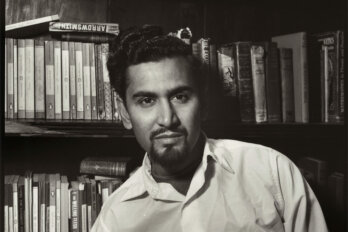Books Discussed in this Essay
Bitten
by Kelley Armstrong
Random House (2001), 576 pp.
Stolen
by Kelley Armstrong
Random House (2003), 576 pp.
Frostbitten
by Kelley Armstrong
Random House (2009), 352 pp.
Of all the supernatural beings that have haunted humanity through the ages—wizards, witches, zombies, vampires, ghosts—the werewolf is perhaps the most unlikely candidate for popular resurrection. It has no tragic, romantic ancestor like Dracula, whose descendants have been idealized of late in pop culture phenomena like Stephenie Meyer’s Twilight. Nor does it recall a cheery, relatable figure along the lines of a Harry Potter, whose adventures have elevated the wizard to Beatle-like status among children and adults alike.
In European folklore, werewolves were lurking figures, half-man/half-beast, fanged and clawed killers of livestock and the occasional human. The overbearing moralism of such fables has led us to see the creatures mainly as villains in cautionary tales for children—keeping them out of the forest and safely in bed after nightfall, when the moon drives the werewolf through his ungodly “Change.” But in the past decade, a Canadian named Kelley Armstrong has taken this frightening, even pathetic figure and made it surprisingly au courant.
In a bestselling series of books with terse titles like Bitten, Stolen, Broken, and, most recently, this fall’s Frostbitten (set in Alaska), Armstrong posits that werewolves are alive and well, albeit living in relative seclusion in upstate New York. They hold jobs, use cellphones, and have gym memberships. The books are the kind of mass-market fiction you see people reading without dust jackets on the subway, unable to suppress a telltale grin. Like Stephen King, who manages an under-the-covers, flashlight-in-face kind of storytelling without sounding ridiculous, Armstrong not only writes interesting page-turners, she has also achieved that unlikely goal, what all writers strive for: a genre of her own.
Bitten, her first novel, was published in 2001 and set the groundwork for much of what has become the eleven-book Otherworld series. (Armstrong’s oeuvre spans a cast of currently chic supernatural characters—Dime Store Magic, one of her best-known titles, is about witches, and her new, wildly successful series of young adult novels features a necromancer named Chloe—but the werewolf is still its throbbing, bloody heart.) As the story opens, thirty-year-old Elena Michaels is making her way through the streets of Toronto, looking for a place to Change. Cities aren’t amenable to mythical beasts, though, and as Elena pokes behind trash bins and half-heartedly stalks petty criminals she exudes something of the frustration many of us might feel at the intersection of Bay and Bloor, pressed to find a water fountain or a place to pee. “These city backstreets are too confining,” she notes. “If I want to run, I must go to the ravine.”
The appeal of Armstrong’s novels, which have appeared on the bestseller lists of both the New York Times and Globe and Mail, lies as much in their hands-on evocation of werewolf life as in their theoretical content. This is not The Call of the Wild ; it’s Nora Roberts meets The Sopranos by way of Henry David Thoreau. Armstrong has mined the best features of airport fiction for storylines with enough sex to appease a romance reader, and enough violence to satisfy a thriller fan. But she has also introduced ideas to keep a non–fantasy fan engaged. It is almost as if Armstrong, who lives in rural Ontario, is on a quest to revive the ideals of Jean-Jacques Rousseau, the philosopher most associated with an optimistic vision of a socialized state of nature. Rousseau held that, free of our civilization’s oppressive influences, humans might stoop to violence but would live within a system of mostly self-governing checks and balances, and thus know a more authentic experience as human beings. Armstrong’s creatures live the lives of wealthy characters in a small-town soap opera, with a taste for skinny-dipping and tiny forest critters. Whenever a stranger comes to the edge of the property and issues a challenge, one of them just “takes care of things.”
In many ways, Armstrong is distilling an aspirational fantasy of contemporary life. These werewolves have it all: They hold great jobs as renowned anthropologists, translators, or artists with New York gallery representation. They live in sprawling estates with Food Network pantries and drive Porsches and Mercedes. In a representative passage, in which the Pack gathers in the leader’s study to sip Scotch by the fireplace or pick up Il Corriere della Sera, Milan’s daily newspaper, werewolves come across a bit like a North American’s idealized concept of Europeans: suave and passionate, yet simultaneously genteel. Such vignettes also suggest that what we really want nowadays is to live the highly commercial existence of contemporary success without abandoning our sense of innate wildness.
When you think about what aspect of human psychology might have led to the werewolf myth, there are many conditions to which an involuntary change might speak: the lunatic, the disabled person, the serial killer. In Armstrong’s conception, the painful transformation from human to wolf occurs not just once a month, as some legends have it, but every few days. By normalizing the Change in this way, she takes the central dilemma of the werewolf’s existence and puts it somewhere in line with a backache or a migraine; it’s inconvenient, but not so distant from the realm of human experience that readers cannot relate. In doing so, she also springs the werewolf from the chains of our long-standing collective imagination—the monster lurking in the forest, the Other—and places it at the centre of a highly topical discussion about how to recapture those elemental aspects of our nature that modern life, for all its benefits, has crowded out.
In 1951, J. D. Salinger published The Catcher in the Rye, a book that has become synonymous with the alienation produced by modern life. Holden Caulfield, kicked out of boarding school, wanders his former stomping grounds of upper-crust Manhattan, commenting on the mores and hypocrisies of class. Subsequent shifts in the literary canon—following from social shifts in the politics of race, gender, and sexuality—suggest that the establishment has come to value fiction that speaks to experiences of otherness and alienation. University classes are stocked with books like Toni Morrison’s Beloved, Judith Butler’s Gender Trouble, Ralph Ellison’s Invisible Man—books that articulate experiences of division and injustice, and make the prism of identity one of the most valuable lenses for viewing a text.
During the extraordinary recent surge of fantastical fiction, much has been made of the supernatural as a metaphor for alienation: the lonely vampire, the banished witch, the tormented ghost unwilling to move on. The werewolf is a stronger, wilder figure: if vampires, witches, and ghosts represent the emotional and spiritual aspects of contemporary life, werewolves allude to our physical nature.
Armstrong’s books highlight the ways in which our power, physical and otherwise, is challenged, compromised, driven from us and into the woods. “People are reduced to technological slaves, dutifully pumping data into computers,” complains a lonely researcher in Stolen, the follow-up to Bitten. She then asks Elena to bite her so she can become a werewolf, too. “No more kowtowing to men, pretending I’m dumber than they are, weaker, less important. I want to be everything I have the potential to be,” she declares.
Armstrong further seems to question, through her werewolves, why and how it is that humans forsake certain necessary aspects of our nature. In Stolen, after Elena has escaped a compound where she was held captive by an evil billionaire, she encounters competing desires during her reunion with her lover, Clay. Mid-coitus, he plucks sliced ham and pancakes from a bedside tray, tenderly offering the food so she will not be forced to choose between her two desires. What follows is a sentence that would probably not work in any other kind of book: “As I closed my eyes again, grease dripped onto my cheek, and a slice of ham pressed against my lips. I opened my mouth and chomped it down in a few bites, then sighed and lifted my hips to meet Clay.”
The consumption of pancakes happens a lot in these books. It’s a leitmotif that seems to come up every few pages: at clan gatherings, after a hunt, or simply whenever it’s time to cram in much-needed calories. As Armstrong reminds us, werewolves have gargantuan appetites to go with their gargantuan strength; their time is spent “engaged in the three Fs of basic survival: feeding, fighting, and… reproduction.” Like pillow fights or running naked through a sprinkler, pancakes seem to be a metaphor for a pleasure we’re meant to give up in childhood. When you encounter a scene like Elena and Clay’s reunion, it’s hard not to think of how long it’s been since you last ate pancakes, let alone while in bed with someone you love. The older we get, the less frequently such treats find their way to the table. Pancakes are so filling, so high carb, so indulgent in this world of Atkins and organic muesli. And yet we still uphold them as one of our favourite foods, wishing we could eat them the way a werewolf does: without self-consciousness or guilt.
Armstrong’s novels render the less-tangible aspects of werewolf life, such as friendship, in an equally visceral yet no less poignant and relatable way. Most humans leave behind the tight cliques we form in high school for marriages and careers; not so the members of the Pack, whose bonds remain sealed by right and by nature. A Pack mate would not only lend you a cup of sugar for your soufflé; he would kill to avenge your name. In fact, day-to-day existence is so violent for Pack werewolves that they must learn to dispose of bodies—mostly those of tabloid reporters, hospital technicians, local cops, and especially “mutt” or non-Pack werewolves—without leaving any evidence. Their intensely shared concerns make for the kind of bond you see in buddies who have come back together from war.
Social intimacy also extends to sexual fluidity. Unexpectedly running into a friend, Elena receives a kiss that sweeps her off her feet: “It’s not asexual—nothing is asexual with Nick—but it’s completely non-threatening,” she muses. “I’m his friend and his best friend’s wife, and while that doesn’t stop him from kissing me or slipping into our bed and getting friendlier than a friend should, he means nothing by it… It’s nothing more than it appears to be—another level of the physical play and intimacy that cements Pack bonds.” Titillating sex scenes appear at regular intervals, in any number of inventive positions (though rarely, if ever, doggy style; read into that what you will). These interludes are essential to the books’ pacing, and integral to their appeal.
And what does werewolf sex teach us about human sex? That we don’t have enough of it, for one, and that we are too choosy about where and when it should happen. We boast of the mile-high club, but a werewolf would kill time in an airport tucked away down one of those shadowy, enigmatic corridors you see marked off with Slippery When Wet signs. In the werewolf world, you can hate someone, sleep with them, and then go back to hating them again. Sex can also be the equivalent of expense account dining among urban professionals, serving as a bridge between two independent beings or competitors, allowing someone to come home and think, well, he’s not such a bad guy after all.
Most of us have to negotiate—with our partners, with our bosses—between what is good in the sense of what brings pleasure and what is good in the sense of what we should do. Werewolves don’t sacrifice one form of good for another. Nor do they apologize for bodily functions left unmentioned in polite company, never mind polite magazines. Armstrong’s overarching thesis is the age-old notion that, behind our codes of etiquette and our post-secondary educations and our copies of He’s Just Not That Into You, we’re all animals—and we might do better to acknowledge it more often.
Mind you, some things remain strange and unknowable, even to werewolves. Armstrong’s Otherworld, like our world, is coloured by alien occurrences, equal parts frightening and suggestive: the stereo that turns on by itself in the middle of the night, the room that doesn’t quite feel right, the old friend seen crossing the street who happens to be dead. Her characters react (ironically but understandably, given their physicality) to supernatural phenomena with great skepticism: “You still realize how this sounds,” Elena inquires of a couple of witches who have initiated contact with the werewolves. “You bring me here, issuing B-movie lines like ‘We know who you are.’”
Wisely, Armstrong doesn’t try to explain the whys and wherefores of her magical realm—much like J. K. Rowling’s approach with Hogwarts, where kids simply can fly around on broomsticks, or C. S. Lewis’s with Narnia, where fauns lead the way and play flutes. Instead, she allows the books’ humour and humanity to flourish amid escape, setting mystery and reality against one another in the same universe. Her world is certainly not one humans would want to replicate, as her vivid depictions of the violent side of werewolf life make clear. But it does offer the tantalizing promise of a better answer to those anxieties and half-formed questions that gnaw at us. It says that there are creatures at work there, and they are… like us, only more so.






